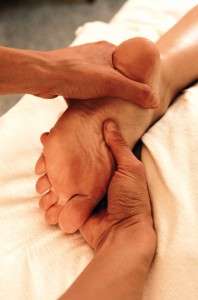 There are many causes of foot and ankle pain such as heel pain, plantar fasciitis, bunion, and ankle sprain. Pain may either be localised in one region or referred to the feet from another area of the body (such as the lower back region). Some foot pain causes present suddenly whilst others appear gradually over time. To know how to treat the problem you need to know where it is coming from and what has contributed to why it has started. An accurate assessment is important with the foot and ankle region to determine the true cause of pain and start you on the right treatment path. You don’t have to have xrays or scans in a lot of cases but when you do need them we will refer you directly.
There are many causes of foot and ankle pain such as heel pain, plantar fasciitis, bunion, and ankle sprain. Pain may either be localised in one region or referred to the feet from another area of the body (such as the lower back region). Some foot pain causes present suddenly whilst others appear gradually over time. To know how to treat the problem you need to know where it is coming from and what has contributed to why it has started. An accurate assessment is important with the foot and ankle region to determine the true cause of pain and start you on the right treatment path. You don’t have to have xrays or scans in a lot of cases but when you do need them we will refer you directly.
What can we do to help foot and ankle pain:
- Physiotherapy assessment of the contributors including the entire leg biomechanics (muscle strength and tightness in the hip region can be a contributor for foot and ankle pain). Providing an individual exercise program for you is a necessary part of recovery from foot and ankle pain.
- Taping of the ankle and / or foot arch can assist reduction of pain and lead to an intrinsic foot strengthening exercise program and also determine the likely benefit of an orthotic in either the short or long term
- Modifying the activity, postures or movements that are causing the pain and modifying them
- Simple things work so start with applying ice carefully to the area which can can help in both recent and longer term problems
- Exercise progression advice for return to normal activity
- Advice on correct fitting footwear that are most likely to help recovery and keep you pain free
A few common ankle and foot problems are:
Plantar Fasciitis
The plantar fascia is a thick fibrous band of connective tissue that originates from under the inner aspect of the heel bone and extends along the sole of the foot before inserting at the base of the toes. It provides support to the arch of the foot and helps us push off when walking. Pain under the arch usually closer to the heel is consistent with plantar fascia pain. The fascia is usually inflamed at its attachment to the heel bone. Pain tends to be worse with first few steps in morning or following a period of extended unloading, i.e. sit down and rest.
There are many potential contributors to the problem. The more common ones are:
- Foot type – i.e. flat feet have more stress on the fascia
- Tight calf muscles
- Older age group
- Overweight
- Footwear/cushion/support
- Overdoing it with exercise–too much, too soon
Heel spurs are a response by the body to extra load on the fascia and are not the primary problem. They are a secondary response. This is true of other parts of the body.
Ankle sprains often resolve quickly but can also become a recurring problem. After an ankle sprain it is important to settle swelling and regain movement and strength before returning to running or sport. The balance system also known as proprioception is also affected by ankle sprains and needs to be re-trained or the chance of further sprains is higher. The more complex ankle sprains that dont recover on a short time frame need to be assessed and often investigated further. Read more here on complex ankle sprains.
